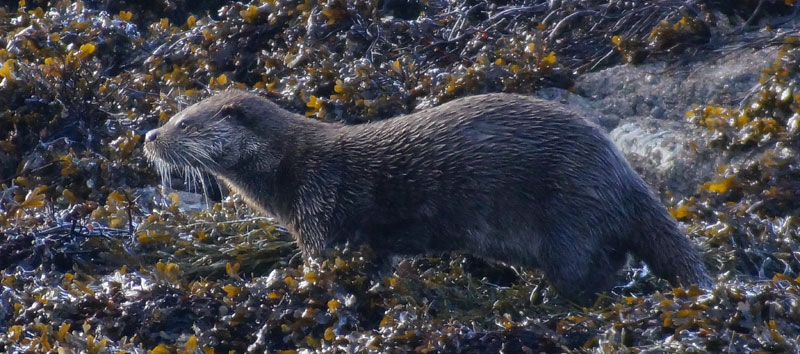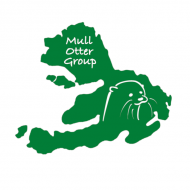Why We Need Guidelines
Otters are a delight to see and what can be better than to watch their antics as they go about their daily business. If people respect the animal and its environment, there should be no problems, but unfortunately this is not always the case. This note is designed to educate people on the legal, moral and practical aspects of watching otters so that disturbance to is minimised, whilst allowing people to enjoy their otter watching experience observing otters responsibly and sustainably.
Otters are Sensitive to Disturbance
Otters are an aquatic mammal which live, shelter and breed on land, but spend most of their hunting time, foraging for food in the water. On Mull that water will be the sea (they can also be found in Mull’s lochs and rivers). There are three main areas of concern relating to disturbance locally to Mull.
Firstly, although otters are very adaptable, science has shown that they can have a very fine line between energy input and expenditure. If they have to spend increasing amounts of energy due to disturbance, it may lead to less efficient foraging, resulting in less food intake, therefore less energy input, leading to loss of condition and hunting ability. A downward spiral then can occur leading to emaciation and death.
Secondly, female otters tend to take their young to the shore at around 12 weeks old, here they gradually learn to be at home in the sea. If people disturb a family group, it can result in young being separated for the adult, possibly leading to a cub becoming lost. This is more prone to occur if there are more than one cub as the female may take one cub to safety, by which time a second cub may have become fatally separated. This can also occur when people only see an adult otter and force it to move along the shore by continually moving toward the otter between dives, each time the otter surfaces it sees people and moves further away. If the cubs are left behind they may become lost of fall to predators.
Thirdly, there is a tendency if someone sees someone else watching an otter they will naturally want to do the same, as more people arrive the otter can become crowded into an area, with nowhere to go, this can extend along a considerable length of coastline. What can also happen in this situation is that two adult otters can be forced to move along a stretch of coastline until they meet, in unnatural circumstances, possibly leading to fighting, which can cause injury and eventually death.
It should be noted that otters can also be disturbed by the actions of people on the shore and adjacent area leading inland. Signs that otters may be present or using the area can be found here. Please use great care if coming across otters on the land as there may be young otters nearby.
Common sense and a respect for the animal that you are looking at are normally sufficient for a satisfactory outcome, but sometimes stronger safeguards may be necessary.
Drivers
Driving slowly along the coast is often the best way to find an otter. Keep your eyes on the road, and let your passengers do the otter spotting. Drive as slowly as you like, but let the vehicle behind past you in the next passing place.
When parking do not block passing places, gates, or driveways. When getting out of the car do not slam car doors or make any noise – you will simply scare the otter away. Your car makes a good viewing hide, so you could be better off staying in it.
Respect other otter watchers, and enjoy better, longer views of otters by not making noise. All too often people report how they were enjoying watching an otter which was oblivious to their presence when the peace was shattered by a car door slamming and someone shouting ‘Look, there’s an otter!’ Unsurprisingly, the otter wasn’t there for much longer.
Walkers
Do not try and get too close to an otter. The most likely result is that you will scare the otter away. You could disturb the otter, prevent it from feeding or returning to its holt, or you could stop a female from returning to its cubs to feed them.
Otters can be resting up among the rocks and seaweed, so take care when walking along the shore. Be careful not to disturb other wildlife such as ground-nesting birds. You could easily tread on eggs or chicks. Retreat if adult birds are agitated or alarm calling.
Respect the flora too, and try not to damage the wonderful array of plants that grow near the shore. You could be treading on orchids or other rare plants.
Photographers
Lots of people want to photograph otters. This has caused several problems on the Isle of Mull in recent years, as all too often people get too close in an attempt to get a closer shot. This disturbs the otter and can prevent it from feeding itself or its cubs. It should be remembered, at all times, that otters are wild animals and deserving of our respect. They are also a protected species under the law, making it an offence to harass or disturb these animals.
A good rule to adopt is never approach an otter if it can see you and knows that you are there. It will simply go away and you will have stopped it going about its normal business. It is possible to quietly get closer to an otter when it is diving for food (a typical dive lasts 20 seconds), if you are downwind, and if you present a low profile. But please don’t push your luck, and please, please don’t disturb otters in the pursuit of a photo.
The Royal Photographic Society has a code of practice: http://www.rps.org/special-interest-groups/nature/about/the-nature-photographers-code-of-practice
Otters and Dogs
Many wildlife enthusiasts are dog lovers and it is understandable that they should wish to walk their dogs along the beautiful coastline which is also the domain of the otter.
The Isle of Mull welcomes dog owners and their well-behaved pets, but be aware of the impact that a free running dog can have. Sheep, cattle, ground nesting birds, and otters can all be disturbed.
It is possible for well-trained dogs to sit while their owners watch an otter at reasonably close range. It is also possible for an otter to become used to the sight of a particular dog. But dogs that are out-of-control and barking in the vicinity of a feeding or resting otter, will invariably result in the otter making a fast getaway. Also, be aware that otters are tough animals with sharp teeth, and could represent a genuine threat to a dog if they are forced to defend themselves.
During Spring and Summer months, many ground nesting birds (gulls, terns and waders) will share the coast which an otter inhabits. Dogs that are off-the-leash pose a genuine threat to the nests, eggs and young of these birds at this time and can cause considerable unseen harm.
Mull Otter Group recommend keeping dogs on the lead in these environmentally sensitive areas.

Otters and the Law
Otters are protected by law.
The Otter is afforded protection under European community legislation by Directive 92/43/EEC on the ‘Conservation of natural habitats and wild flora and fauna’ (the ‘Habitats Directive’) being listed in both Annexes II and IV; the Wildlife and Countryside Act, 1981 (as amended), listed on Schedules 5 and 6; and the Wild Mammals Act 1995.
It is worth looking at the following websites for more information.
SNH: Habitats Directive Regulations
Legislation.gov.uk: The Conservation (Natural Habitats, &c.) Regulations 1994
What this means in practice is that it is an offence to deliberately or recklessly to:
- Capture, injure or kill an otter.
- Harass an otter or group of otters.
- Disturb an otter in a Holt or any other structure or place it uses for shelter or protection.
- Disturb an otter while it is rearing or otherwise caring for its young.
- Obstruct access to a Holt or other structure or place otters use for shelter or protection or to otherwise deny the animal use of that place.
- Disturb an otter in a manner that is, or in circumstances which are likely to significantly affect the local distribution or abundance of the species.
- Disturb an otter in a manner that is, or in circumstances which are, likely to impair its ability to survive, breed or reproduce, or rear or otherwise care for its young.
It is also an offence to:
- Damage or destroy a breeding site or resting place of such an animal (note that this does not need to be a deliberate or reckless to constitute an offence).
- Keep, transport, sell or exchange or offer for sale or exchange any wild otter or any part or derivative of one (if obtained after 10th June 1994).
Further Codes of Conduct
Codes of conduct can be found on the following websites:
Scottish Natural Heritage https://www.nature.scot/professional-advice/land-and-sea-management/managing-coasts-and-seas/scottish-marine-wildlife-watching-code
Wild Scotland watching wildlife on foot http://www.wild-scotland.org.uk/about-us/wild-scotland-best-practice-guidelines/watching-wildlife-on-foot-apr07-lo-res/
Wild Scotland watching wildlife from a sea kayak http://www.wild-scotland.org.uk/about-us/wild-scotland-best-practice-guidelines/
Many thanks to Nigel Burch for providing a large part of the content of these guidelines.
